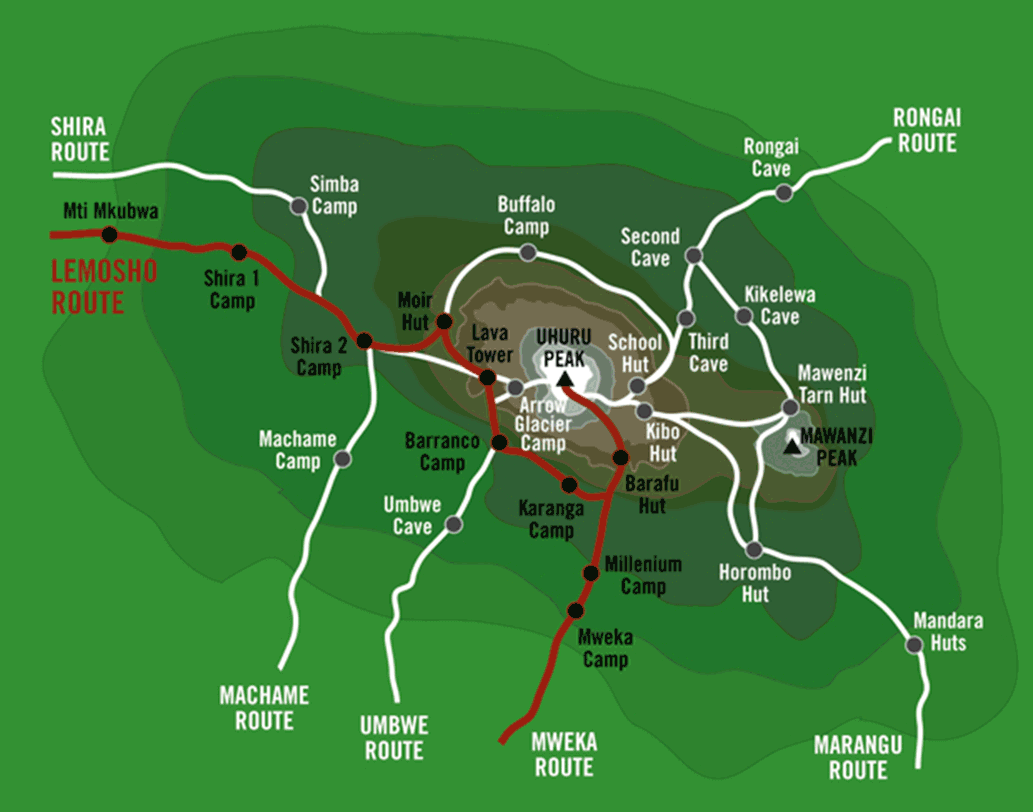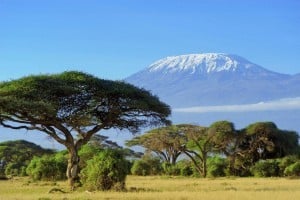Lemosho Route:
Day one:
To / from: Londorossi Gate (2100 meters) – Mti Mkubwa Camp (2750 meters).
Duration: 3 hours.
Setting: Tropical rainforest.
You depart from Moshi or Arusha to the Londorossi National Park Gate, here fills you with your guide the necessary paperwork, the climb can begin below. The first day to Mti Mkubwa camp is a simple route (two to three hours), you walk on a trail through the rainforest up, you get a multitude of monkeys and tropical birds at even zebras, impalas and giraffes can encounter here because there are buffalo roam you will be accompanied by an armed ranger. Arriving at the camp, you can enjoy the environment, and dinner.
LB, AM.
Day two:
To / from: Mti Mkubwa Camp (2 750 meters) – Shira Camp 2 (3840 m).
Duration: 6 to 7 hours.
Surroundings: Moorland (lunar).
Today you leave the tropical rainforest, and starts the ‘moorland, this is a lunar landscape of sand and stone with only a few cacti here and there, lobelia and proteas. You can route to the Shira Cave, take a stroll to the Shira Cathedral, these are huge rocks. Arriving at the camp, you have one of the best views of the whole mountain, you will see include the ice walls of Kibo, and the rock face of the Shira Plateau. The view of Mount Meru is great.
O, LB, AM.
Day three:
To / from: Shira Camp 2 (3840 m) – Lava Tower (4630 meters) – Barranco Camp (3950 meters).
Duration: 7 hours, about 15 km.
Environment: Desert.
You wake up with a beautiful panoramic view over the vast savannas. You let ‘moorland’achter you now walk between the lava rock of the’ western breach. After you have lunch at the Lava Tower at 4630 meters, you descend to the Barranco valley at 3950 meters. Barranco camp is characterized by steep cliffs and deep ravines.
O, LB, AM.
Day four:
From / to Barranco Camp (3950 meters) – Karanga Camp Site (4000 meters).
Duration: 3 hours, 4 km.
Environment: Alpine Moorland.
The path rises steeply from the Barranco Valley to the southeast flank of Kibo, with superb views over the plains. You will have lunch in the Karanga Valley, and here is the last water point.
O, LB, AM.
Day five:
From / to Karanga Camp Site (4000 meters) – Barafu Campsite (4700 meters).
Duration: 3 to 5 hours.
Environment: Desert.
You walk today along the ice walls and snowfields, to the Barafu Campsite (Barafu means ice), the top is now very close! Arriving at the camp equips you for the long journey to you the next day ahead.
O, LB, AM.
Day six:
To / from: Barafu Campsite (4700 meters) – Uhuru Peak (5895 m, top) – Mweka Camp (2800 meters).
Duration: Barafu Campsite – Uhuru Peak 6 to 7 hours, Uhuru Peak – Mweka Camp 5 to 6 hours.
Environment: snow / ice fields, moorland.
You are in the middle of the night, at around one o’clock to begin the ascent to the summit. You leave the camp and climbs in about five to six hours to Stella Point, where you can rest a bit and you will see an unforgettable sunrise. After that you climb in about two hours at the actual summit; Uhuru Peak, after you take pictures here can begin the return journey. You walk out of Uhuru Peak to Mweka Camp in about five to six hours. By now you sit up there a climb of about twelve to fourteen hours, and is exhausted but happy in the camp, where you will likely find your bed immediately.
O, LB, AM.
Day seven:
From / to Mweka Camp (2800 meters) – Mweka Gate (meters).
Duration: 3 to 4 hours.
Setting: Moorland, tropical rainforest.
After breakfast begins the retreat, where you descend the last hour through the tropical rainforest, where you will encounter the necessary mountain rivers. Arriving at the gate, you will be in Moshi or Arusha to your hotel, where you can take a refreshing dip in the pool!
O, LB
* It is also possible for this route in six days to do, then you climb on day four of Barranco Camp to Barafu Camp Site, this trip takes approximately seven hours. *
Included:
National Park fees, camping fees, rescue fees.
Full board camping accommodation during ascent.
English speaking guide, cook and porters.
Camping materials.
Getting to Kilimanjaro, and back to Moshi / Arusha.
Three meals a day
Sleeping bag and mattress
Not included:
Meals and accommodation in Arusha
Personal expenses and gratuities.
Toiletries
Tips
Prices:
Six days, five nights
2 persons: 1395€ per person
3+ persons: 1345€ per person
Plus € 40 pp for Forest fees and transport.
Most of our customers climb this route in eight days.
If you have reached Stella Point or Uhuru Peak, you get at the entrance / exit a certificate with the message that you have reached the highest point in Africa.
Beware!
Climbing Mt. Kilimanjaro is often taken lightly, because we no ropes, irons or other attachments need, this does not mean that you will reach the top. Every year approximately 22 000 people start the climb to the summit of Mount Kilimanjaro only 60% gets the actual summit also (Uhuru Peak). 40% do not make it have different reasons, it may be because their condition is not good enough, or that they deal with altitude sickness get (throbbing headache, vomiting, nausea, and feeling tired and lethargic), in most cases, this time will be noticed by your guide, but unfortunately there are still too many incompetent guides, or not notice this too late.
Every year people die by incompetent guides, be sure you book with a professional and competent company.
I climbed itself Kilimanjaro second time, it is a fantastic ascent you the rest of your life with will continue, but beginning well organized the climb, these are a few tips which I definitely would recommend, also improve these tips your chances of reaching the summit considerably:
Train at least two months before your departure two to three times a week, you can go jogging or take long walks.
Train with a backpack of at least five kilos you carry on Mt. Kili itself a backpack that weighs about five kilograms (packed lunch, camera, binoculars, water, etc.), if you’ve never trained with this you get great muscle soreness in your shoulders.
Walk in your shoes, so do not go with brand new shoes on the mountain.
Get enough socks dry, this helps prevent blisters.
Take a high factor sunscreen, factor 25 or 30, at 3000-4000 meters altitude you naturally burn faster.
Take muesli bars and glucose along (dextro energy).
Enough warm clothes (flees).
Sufficient water purification tablets.
Norit tablets.
Good sunglasses (with UV filter).
Any tablets that help prevent altitude sickness, such as Diamox.
Headlamp or flashlight.
Rainwear.
Reading book and / or music.
Drink plenty of water during each trip.
Walk slowly and enjoy the surroundings. (too quickly climb up increases the risk of altitude sickness).




